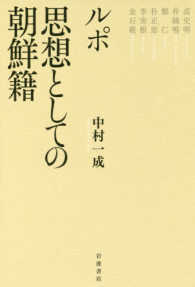- ホーム
- > 洋書
- > 英文書
- > Science / Mathematics
Full Description
This book highlights recent advances of spectroscopic techniques based on Raman scattering. Different applications are introduced that serve as examples for the versatile use of Raman techniques. Raman spectroscopy is a marker free technique, which is capable of yielding detailed information about molecular systems in a non-destructive way. This makes it a valuable tool for, e.g., material science or medical research. The access to vibrational energy and dynamics yields fundamental insights into static and dynamical structural properties of molecules being influenced by and influencing their material science or medical research environment. The better understanding of the basic building blocks of materials helps to improve the functionality in various applications. Raman spectroscopy has become a truly interdisciplinary research tool, and the ongoing development of techniques makes it attractive for growing variety of scientific and industrial applications, which will be demonstrated in the book. While the "classical" linear spontaneous Raman spectroscopy is restricted in its applicability due to low signal intensities or the excitation of strong fluorescence background, new techniques have helped to overcome such problems. Examples, presented in the book, are surface-enhanced Raman scattering (SERS), and various associated techniques are used to drastically increase signal intensity, confocal, and tip-enhanced Raman scattering (TERS) allowing for high and even sub-diffraction limited spatial resolutions, coherent anti-Stokes Raman scattering (CARS) avoiding fluorescence background and allowing for time-resolved observations of vibrational dynamics, or hyper- and resonance Raman scattering influencing the scattering based on electronic resonances, etc.
Contents
1. Linear Resonant and Non-Resonant Raman Spectroscopy.- 2. Magnetic Field and Pressure induced Raman Spectroscopy.- 3. Optothermal Raman Spectroscopy.- 4. Polarised Raman Spectroscopy.- 5. Use of Optical Tweezers in Raman Spectroscopy.- 6. Raman Optical Activity Spectroscopy.- 7. Surface-Enhanced Raman Spectroscopy (SERS).- 8. Electrochemical SERS.- 9. SERS Excitation Spectroscopy: Single Molecule Detection.- 10. Tip-Enhanced Raman Spectroscopy (TERS).- 11. Hyper and Stimulated Raman Spectroscopy.- 12. Coherent Anti-Stokes Raman Spectroscopy (CARS).- 12. Imaging-Based Raman Spectroscopy.- 13. Surface-Enhanced Femtosecond Stimulated Raman Spectroscopy.- 14. Brillouin-Raman Micro-Spectroscopy (BRaMS).







